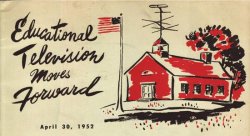Montclair State Celebrates 60th Anniversary of Historic Educational Telecasts
Posted in: School of Communication and Media News

On April 30, 1952, Montclair State University—then the Montclair State Teachers College—made television history. According to documents prepared at the time, Montclair State was “undoubtedly the first” to use a non-commercial Ultra High Frequency, or UHF, channel to broadcast a full day of educational telecasts to schools.
“The broadcast showed that there was a great potential for bringing a different kind of education to children,” said Maxine Minkowitz Soren ’54, a speech major who was one of 29 students who developed and produced the programs.
A Full Day of Classroom Programming
Eight one-half hour lesson programs planned by Bloomfield and Montclair, New Jersey, public school teachers were transmitted to classrooms in 13 schools over UHF Channel 54 from 8:50 a.m. until 3:20 p.m. Programs were tailored to elementary, junior high, and high school students to demonstrate television’s educational potential. The mayors of Bloomfield and Montclair participated in the opening program, “We Visit Our Town.” In the afternoon, Raye R. Platt of the American Geographic Society showed how maps are made. Other programs focused on everything from current events to Spanish.
As a technical director, Diane Schorn Lenartowicz ’54 instructed the camera crew and the people on set. “We’d learned so much by the day of the broadcast. We’d learned to use cameras, controls, make quick decisions and adjustments, and work as a team. We were very, very comfortable with everything,” she said.
Montclair Partners with DuMont Laboratories
The groundbreaking broadcast was the result of collaboration between Montclair State and the Allen B. DuMont Laboratories, Inc. Montclair State president Harry A. Sprague and his successor E.D. Partridge worked with Allen B. DuMont, a Montclair resident, television pioneer, and head of the DuMont Television Network to teach students about TV. With DuMont’s initial donation of a black-and-white image-orthicon tube camera and several monitors, Montclair State’s television workshop program was up and running.
“The broadcast was a part of the television workshop class. We were expected to be up-to-date with technology and develop and produce a television program. We couldn’t get over the high-tech equipment that was available to us,” recalled Soren.
Gym Transformed Into Campus Broadcast Studio
Montclair State’s gymnasium was transformed into a professional television studio on April 30, 1952. While students in the television workshop course wrote scripts, produced and directed the programming, and served as camera operators and even on-air talent, DuMont Laboratories technicians were on hand to troubleshoot if needed.
Hawthorne, New Jersey resident George Iannacone ’54 described the cumbersome equipment. “The cameras were heavy and clumsy. They were mounted on wooden tripods set on wooden dollies.”
About a week before the broadcast, special 21-inch receiving television sets, converters, and antennae were moved into classrooms in the 13 participating schools, so that the 300 students in those classrooms could get used to them. At least 1400 students in total took advantage of the opportunity to check out the programming.
More than a hundred visitors—including guests from New York University, New York and New Jersey State Education Departments, Ohio Wesleyan University, Fordham University, the University of North Carolina, and reporters from The New York Times and the Passaic Herald News—viewed the programs on a television set at the on-campus College High School Auditorium or watched actual filming in the gymnasium.
Montclair State’s Edward C. Rasp, Jr., who was trained by DuMont Laboratories and their television station WABD, directed the project. Montclair State Speech Division Chair L. Howard Fox and Walter Kops of the Social Studies Department were equally instrumental in the planning, production, and success of the telecast. The DuMont Laboratories and the Allan B. DuMont Foundation subsidized much of the $10,524 cost of the day’s telecast.
A Transformative Educational Experience
Montclair State’s early television workshops made a lasting impact on many students.
Speech major Betty Ann Boettcher ’54, who was a floor director for the historic telecast, was offered a job in Boston in educational television after graduation. “I couldn’t take it, though, because I was getting married and my husband was in the service,” she said.
Student cameraman, Bob Parkinson ’54, went on to earn a PhD in Communications from Syracuse University. For more than twenty years, he taught television production at Northwestern University in Evanston, Illinois. “I showed clips of the Montclair State broadcast to my students in my Television and Education course to give them a sense of the possibilities of the earliest days of educational TV,” he recalled. “Montclair State was on the leading edge. It was a fascinating experience to be involved in that early on.”
Iannacone remembered that the group was “entranced by television. Educational television taught us all about tomorrow. We knew this hot new medium was going to completely alter the way people learn.” The experience left the now retired school superintendent with a conviction that “teaching is a performing art—the best teachers are also great performers.”
“We were a jolly bunch,” said Soren, a retired educator and Hackensack, New Jersey resident. “We worked hard, laughed a lot, and had fun.”
“April 30, 1952 was a day that was the beginning of many things,” Lenartowicz concluded. It was a day that put Montclair State at the forefront of a brave new world of educational broadcasting.
Image Gallery
Click on an image below to enlarge photo.

